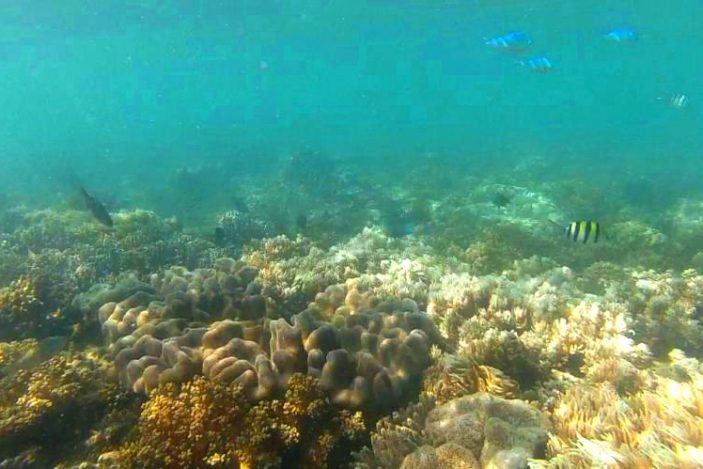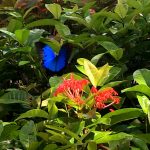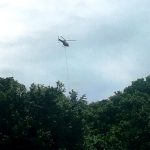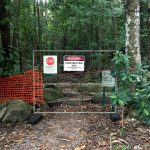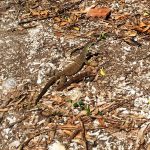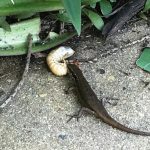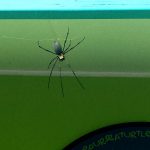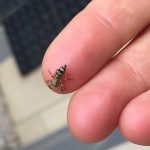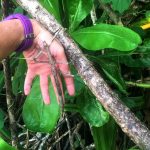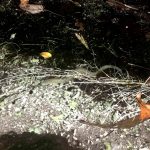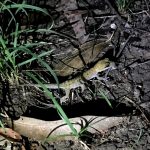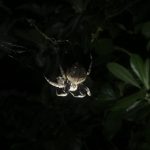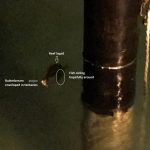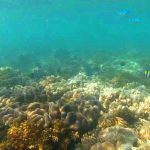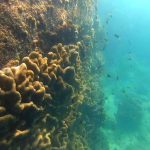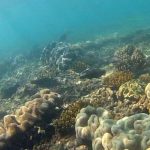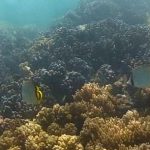June has been a really intense month as far as the wild life goes- this island has just taken it to a whole new level! It’s difficult to know where to begin but I’ll throw my mind back to the start of the month and see what I can tell you. So last month Ella the Green Sea Turtle left Fitzroy Island and was sent back into Cairns to be fitted with a satellite tracker ahead of her release. And what an incredible release it was- you may have caught the coverage of it on 60 Minutes.
Incredibly Ella did not shoot off into the distance the minute she hit the water (as every other turtle has ever done) but she actually hung around for a while swimming up to the volunteers (whom she could pick out of the snorkelers in the water) and nuzzling up to them; swimming between their arms and around their bodies for a considerable period of time before she finally departed.
She is the only turtle to have ever done this and she certainly left a few volunteers feeling the strain on the heart strings. Margaret and Rinnie have been in fine form this month. Little Rinnie moved into the display tank and is getting more comfortable with people every day but I recently discovered that this cheeky little chap has been taking advantage of me.
A few months back I happened to stumble across a bit of purple cabbage and cauliflower and decided to give some to the turtles as a treat. Ever since that day Rinnie has refused to eat lettuce when I give it to him (he spits it out).
I have been making special shopping trips to buy him purple cabbage and cauliflower as he left me with the distinct impression that he will not eat anything else. Or so I thought. The other day I was chatting with some of the other volunteers and I made the startling discovery that this crafty little critter is still eating lettuce for everyone else- he has just learned that by refusing to eat it for me I will bring him his favourite treats instead!!!
Unbelievable. Margaret has been less diabolical but certainly just as temperamental this month. As I am usually the last volunteer to see the turtles at the end of the day I do a check of the tanks and make sure that everything is working and every turtle is happy before I leave.
But I feel sad when I go as I am leaving them alone until following morning so when I can I like to give them treats as I’m leaving so that they are both happy and their attention is occupied for a period of time. I always give them a big wave when I leave so that they know when I am saying goodbye.
Margaret cottoned on to my technique and decided to try a little tactic of her own. When I waved goodbye and threw in her treats she ignored them and followed me around the edge of the tank as I moved toward the gate. She looked so sad that I just had to spend some extra time with her.
After another ten minutes she was apparently satisfied and moved on to eat her food. After a couple of days of this I made a mistake. I gave her a load of treats and waved goodbye as usual but as it turned out she was so distracted chasing her cabbage, lettuce and broccoli around that she didn’t actually see me wave. The end result was one very cranky turtle when she realised I had disappeared!
I of course was oblivious to this until the next day. I came bounding up to Margaret’s tank armed with her favourite food only to be met with an icy glare. Now usually when I go to see Margaret she is swimming around doing her own thing, sees me coming and races over to meet me. On this particular day she was sitting in the middle of her tank.
You could almost hear the drum of fingernails as she waited. As soon as I came in and tried to engage her she made quite the show of picking herself off the bottom and swimming ever so slowly to resettle on the other side of the tank with her back to me. Over the next ten minutes she continued to look ever increasingly haughty as I moved around to face her and offered a variety of her favourite treats.
At one point I was stretched out like Gumby desperately flapping a piece of purple cabbage in her face as she pointedly ignored it and continued to act as though I didn’t exist. I have to say that I was impressed by her self control as purple cabbage to her is like lemon meringue pie to me and if someone was waving one of those in my face I daresay I would forget my grudge and dive straight in.
And if I’m honest it would be face first; forget the spoon. Well there was nothing I could do but give her a big wave goodbye and let her be. The next day she was over it and raced to greet me as happily as ever but I learned my lesson and am now quite pointed about waving her goodbye and then, in the same movement, showing her the treats I’m about to give her so that she understands that I won’t be there when she finishes eating.
She pops her head right out of the water to look at me so I know that she is paying attention. It’s a learning curve with these turtles and even after three years I’m continually being challenged.
And while we are on the subject of turtles- a fresh water turtle has been seen several times near the staff quarters! Unfortunately the little chap is incredibly shy and it is only those that are the first to rise (at 5am or earlier) that have seen it. As soon as it perceives movement it disappears into the deep freshwater pool near the staff quarters. We are hoping to get a photo of it soon and the Queensland Park Rangers are eagerly anticipating identifying the species. There are numerous fresh water springs across Fitzroy Island and most are rather small so it is not surprising to discover this chap has made the deeper pool his home after stumbling across it.
Speaking of stumbling across things, one day when I was coming back from the Turtle Centre I cut back along the track between the Resort rooms and the Beach Cabins and happened to come upon a very determined (and quite frankly more than a little bit greedy) Bar-Sided Skink dragging a funny looking grub that was HUGE in comparison! The skink could barely move but it was so overjoyed at its catch that it was making every effort to drag it up the path on millimetre at a time. At first I took the grub to be a Witchetty Grub which really surprised me to find on the island. At one point the skink dropped it and I eagerly pounced on the opportunity to get a few good snaps in the hopes that I could ID the grub afterwards. Unfortunately the poor little skink only waited a few seconds and then decided that it had lost its meal to a larger predator so it gave up and trailed into the bushes. I felt very guilty after that and tried to place the grub back where the skink could retrieve it but I didn’t see the exact spot that it left the path so I really have no idea whether it got its reward or not. I feel quite guilty about it too. Although as it turned out the photos did allow for an identification (silver lining) – I haven’t heard back from the experts at the Queensland Museum yet but I posted the photos on Facebook hoping that some of my friends might recognise it and after a fierce debate between a few passionate individuals one triumphed with an unmistakeable identification- a Rhinoceros Beetle grub. The Rhinoceros Beetle is a common beetle found around the island that has an unmistakable profile and produces hissing squeaks when annoyed by rubbing its abdomen against the ends of the wing covers. Until this day I had never seen the grub. Only the males have the characteristic horns from which they earned their name. When a female is present she exudes a hormone that excites the males to combat each other; using their horns to try to knock their opponent off the branches and into the leaf litter below. As adults the Rhinoceros Beetles feed on the soft bark of young tree shoots (and have been known to harm a few when several beetles are congregated). The larvae on the other hand feed on decomposing vegetable material and are invaluable in accelerating its break-down into compost- making them an essential component of the Rainforest Ecosystem which relies greatly on nutritional recycling. Females lay around 50 white eggs into a patch of decaying vegetable matter (they quite like Bush Turkey nests so on this island it would be natural to assume they are prominent through the Orange Footed Scrub Hen nests here on the island as they are a member of the Bush Turkey family). The eggs take around three weeks to hatch and up to eight months for the grub to morph into the adult. This is a really cool process- when the grub is at its final larval stage it builds a cell in the soil which it then decorates lavishly with its own faeces (aren’t you glad you’re not a grub?) This then solidifies into a waterproof layer around the cell. Inside this safe space the larva will then transform into a pupa and after roughly a month the adult beetle hatches out and digs its way to the surface. The average life expectancy for the adult beetle is between two and four months. And speaking of getting answers from the Queensland Museum I finally heard back regarding the unusual ant pictures I sent in from last month (the ant with the clear bubble attached to its abdomen). After several weeks debate the Entomologists gave the following account:
“We don’t really have a definitive answer for this one. The ant may have a deformity or could have been partially squashed at some stage, leading to liquid being lost and subsequently dried on the abdomen. We don’t know for certain if the liquid originated from the ant, so we can only speculate. There is nothing about the observation that can be clearly linked to a typical behavioural trait exhibited by green ants.”
While it obviously does not provide an answer to my query, I was quite delighted to discover I had witnessed something so unusual that even the experts couldn’t explain it. One thing that really needs no explanation is the Goliath Stick Insect that turned up at the Turtle Rehabilitation Centre. It was on the gate one day and there was some concern that it may get squashed so one of the volunteers gentle ‘persuaded’ it to relocate (okay she picked it up and carted it to the nearest bushes). It grabbed a hold of the shrubbery and remained there for two days without moving. On the second day I pointed it out to a my turtle tour group as we walked past. I had just mentioned that she hadn’t moved for two days when I realised she was only holding on to the branch with one leg. Thinking it looked uncomfortable I scooped underneath and gently raised her body (I believe it was a girl owing to the small wings but I’m not 100% sure of this) so that she could get a better grip. She didn’t react at all! After half a second the tour group was suddenly very amused when the realisation dawned on me that the reason she hadn’t moved was that she had actually died. Whoops. If Roberta had still been around I would have thrown the body into her web to watch her reaction but unfortunately she has left us. Roberta was one of the Golden Orb Spiders to set up a web in front of the Turtle Centre last month. The other spider vanished overnight at the beginning of June but Roberta stayed on getting plumper as she continued to catch as smorgasbord of insects. She was proving to be quite popular amongst the visitors; even amongst those that didn’t like spiders. And then unfortunately one day a vandal came along and destroyed her web. For two days she hung sadly from the Centre roof and I hoped against hope that she may re-spin her web but she didn’t. On the third day she simply picked up and departed. I’m a little sad and even after a week I still catch myself glancing expectantly toward the building hoping to see Roberta perched atop and gleaming new web.
Left to Right: The Ulysses Butterflies have returned. As has Frankie the baby Yellow Spotted Sand Monitor- he is bigger now but we always know Frankie because of the characteristic bite missing from his tail (it happened when he was very young). The Secret Garden Track is currently undergoing repair thanks to the Queensland Park Rangers who flew in several tons of equipment via helicopter. Photos by Jen Moloney
Let to Right: Roberta hangs sadly from the remnant of her web. The Goliath Stick Insect is transferred to a nearby bush. This Jumping Spider decided to create a web stretching right across the main stairway while this over-enthusuastic Bar-Sided Skink bit off more than it could chew when it captured the grub of a Rhincoeros Beetle. Photos by Jen Moloney
One night I was feeling a bit restless so I decided to take myself for a hike to the Lighthouse and there-a-bounds. It was quite enjoyable. I really enjoy exploring and I find something really relaxing about doing it at night- but I am not advocating for anyone else to do it as the night has a pitfall of potential dangers such as sudden holes in the ground, rickerty stones that give way underfoot and an abundance of spiders out and about. However, that said, this was one of my most enjoyable forays. I came across some young Eels in the ‘World’s Smallest Fresh Water Creek’ on the way to the Campground. They were taking advantage of the mud and leaf litter but I did manage to snap a picture of one that was pretending to be a stick. Up at the Lighthouse I came across a Leaf-Curling Spider that was eating a juicy bug with an almost indecent relish. I’ve never seen anything like it. Fortunately he was not at all disturbed by the light of my torch and if anything, took an even greater delight in having an audience to watch his feeding frenzy. After spending an enjoyable few hours walking around I retraced my steps down the Lighthouse track and almost ran smack-bang into the web of a Garden Orb. The spider had just captured a tasty treat of its own and it was having a grand time wrapping it. After watching for a while I ducked under the web, had one last look at the Eels in the creek and then headed for the jetty. I am a big advocate for checking out the jetty at night because you never know what delightful treat you may witness amongst the hunting fish. One guest was lucky enough to see a Lionfish attacking a second Lionfish! I’ve never heard of that before and can only surmise that one may have told a ‘Your Mama’ joke. On this particular night as a fantastic end to my night time adventure I saw a large squid eating one of the Butterbream fish- I’ve often seen them hunting the smaller Baitfish side by side and I had no idea that the squid will happily capture and devour one of their allies! A second fish, it reminded me in shape of a Sweetlip or Perch but I really couldn’t say for sure, was darting around trying to pick up scraps of flesh as the squid tore into the fish with its beak. It had its tentacles wrapped around the Bream which was well and truly dead by this stage. I took some photos but they weren’t the best quality. Still, hopefully you can make out a few of the details.
Left to Right: The Eels freezes (Centre) and tries to camoflauge with the background. These little Geckos were everywhere and I had to be really careful where I put my feet to avoid stepping on them. This Garden Spider had her fangs sunk into its prey just as the Reef Squid ate the Butterbream it caught. Photos by Jen Moloney
Not to be outdone by the night predators the Black Tip Reef Sharks were at it again. I was on Nudey Beach one day when my Husband spotted a school of Baitfish in the water. We knew what that would attract and sure enough within ten minutes we saw the first small fin slice the water surface. Within half an hour there were four sharks sporadically charging through the school, and driving them further into the shallows. One was quite large and took advantage of the tiny wave crests to surge over the top of the shallowest reef and snatch a gobfull of wriggling fish. Unfortunately we were never fast enough to capture a photo of him doing this but we did get a few to commemorate the afternoon. However I did pay the price afterwards- I was so excited watching them that I forgot to reapply the sunscreen and as result was rather burned the next day.
To end this month’s wrap I think I will leave you with some of my favourite photos that I took of the reef this month. What else could really summarise the splendour that has been June?
Okay so this last one is not the reef but it was arguably one of the most beautiful sunsets I’ve ever seen! Photos by Jen Moloney
Jen Moloney – Marine Biologist & Tours Co-Ordinator


